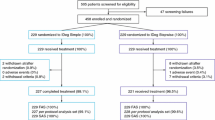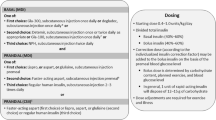Abstract
It is a daunting task to initiate or evaluate continuous subcutaneous insulin infusion, pump, dosing in a patient with type 1 diabetes. Choosing a low dose may lead to hyperglycemia or, too high, hypoglycemia. Mathematical dosing guidelines were used with the first human insulin injection in 1922. Since that time, they have been enlarged and modified. The current widely published guidelines were developed from retrospective evaluations of pump-downloads in patients without specified diet conditions or timed glucose testing. When diet is controlled and glucose testing is timed to evaluate post-meal excursions and during sleep, recent prospective studies found that these current dosing recommendations for basal insulin were too high and for bolus insulin too low. Further, simple mathematical interrelationships were published that kept the right proportions between the bolus dosing factors and the basal dose.
Similar content being viewed by others
References
Papers of particular interest, published recently, have been highlighted as: • Of importance
Bliss M. The Discovery of Insulin. Chicago: University of Chicago Press; 1982.
https://www.diabeteseducator.org/export/sites/aade/_resources/pdf/Insulin_Pump_White_Paper.pdf. Accessed February 1, 2014.
King AB, Clark D, Wolfe GW. The contribution of the dawn phenomenon to the fasting and post-breakfast hyperglycemia in type 1 diabetes treated with once-nightly glargine. Endocr Pract. 2012;18:558–62. Review of the effect of the dawn phenomenon in basal insulin dosing.
Heinemann L, Nosek L, Kapitza C, Schweitzer MA, Krinelke L. The time until a change in metabolic effect is induced in patients with type 1 diabetes. Diabetes Care. 2009;32:1437–9. Reminder of the delay action of basal rate change in pump-treated type 1 diabetes.
King AB, Armstrong D. A prospective evaluation of insulin dosing recommendations in patients with type 1 diabetes at near normal glucose control: basal dosing. J Diabetes Sci Technol. 2007;1:36–41.
Wolpert HA, Atakov-Castillo A, Smith SA, Steil GM. Dietary fat acutely increases glucose concentrations and insulin requirements in patients with type 1 diabetes: Implications for carbohydrate-based bolus dose calculation and intensive diabetes management. Diabetes Care. 2013;36:810–6.
Pankowska E, Blazik M, Groele L. Does the fat-protein meal increase postprandial glucose level in type 1 diabetes patients on insulin pump: the conclusion of a randomized study. Diabetes Technol Ther. 2012;14:16–22.
Standards of medical care in diabetes-2014. Diabetes Care. 2014;37(Suppl 1):s14–67.
Handelsman Y, Mechanick JI, Blonde L, et al. American association of clinical endocrinologists medical guidelines for clinical practice for developing a diabetes mellitus comprehensive care plan. Endocr Pract. 2011;17 Suppl 2:1–53.
DeWitt DE, Hirsch IB. Outpatient insulin therapy in type1 and type 2 diabetes. JAMA. 2003;289:2254–64.
Bode BW. Insulin pump therapy in Therapy for Diabetes Mellitus and related disorders, Fourth edition. In: Lebovitz HE, editor. American Diabetes Association; 2004.
Insulin pump therapy and continuous glucose monitoring. In: Pickup J, editor. London: Oxford University Press; 2009.
Kruszynska YT, Home PD, Hanning I, Alberti KGMM. Basal and 24-hour C-peptide and insulin secretion rate in normal man. Diabetologia. 1987;30:16–21.
Polonsky KS, Given BD, Van Cauter E. Twenty-four-hour profiles and pulsatile patterns of insulin secretion in normal and obese subjects. J Clin Invest. 1988;81:442–8.
Davidson PC, Hebblewhite HR, Steed RD, Bode BW. Analysis of guidelines for basal-bolus insulin dosing: basal insulin, correction factor, and carbohydrate-to-insulin ratio. Endocr Pract. 2008;14:1095–101.
Walsh J, Roberts R, Bailey T. Guidelines for insulin dosing in continuous subcutaneous insulin infusion using new formulas from a retrospective study of individuals with optimal glucose levels. J Diabetes Sci Technol. 2010;4:1174–81.
King AB, Armstrong DU. A prospective evaluation of insulin dosing recommendations in patients with type 1 diabetes at near normal glucose control: bolus dosing. J Diabetes Sci Technol. 2007;1:42–6.
Kuroda A, Kaneto H, Yasuda T, et al. Basal insulin requirement is 30 % of the total daily insulin dose in type 1 diabetic patients who use the insulin pump. Diabetes Care. 2011;34:1089–90.
Kuroda A, Yasuda T, Takahara M, et al. Carbohydrate-to-insulin ratio is estimated from 300-400 divided by total daily insulin dose in type 1 diabetes patients who use the insulin pump. Diabetes Technol Ther. 2012;14:1077–80.
King AB. Continuous glucose monitoring guided insulin dosing in pump-treated type 1 diabetes: A clinical guide. J Diabetes Sci Technol. 2012;6:191–203.
Acknowledgments
The author recognizes the editorial assistance of Stacey Condren and Dawn Clark.
Compliance with Ethics Guidelines
ᅟ
Conflict of Interest
Allen Bennett King has been a speaker, consultant, and has received research support from Novo Nordisk, Sanofi, Lilly Inc.
Human and Animal Rights and Informed Consent
This article does not contain any studies with human or animal subjects performed by any of the authors.
Author information
Authors and Affiliations
Corresponding author
Additional information
This article is part of the Topical Collection on Treatment of Type 1 Diabetes
Rights and permissions
About this article
Cite this article
King, A.B. Reassessment of Insulin Dosing Guidelines in Continuous Subcutaneous Insulin Infusion Treated Type 1 Diabetes. Curr Diab Rep 14, 503 (2014). https://doi.org/10.1007/s11892-014-0503-3
Published:
DOI: https://doi.org/10.1007/s11892-014-0503-3




